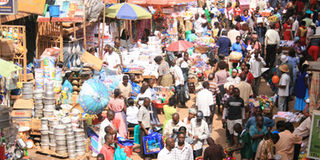BRICS scramble for Africa markets

Most products sold in Uganda are imported from China. PHOTO BY ISAAC KASAMANI
Recently, the BRICS—Brazil, Russia, India, China and South Africa—met in the Chinese resort of Sanya and called for changes in international financial institutions and a move away from the dollar.
Comprising 40 per cent of the world’s population and a quarter of the global economy, this new organisation appears to represent an important sign of declining American influence. But such appearances are misleading.
Mandela National Stadium – Namboole, the 45,202 capacity stadium, built using a $36 million grant from China, is the largest and by far the most modern sports arena in the Uganda.
China trade with Uganda
The Chinese government is also behind the construction of the new President’s Office - estimated to cost $25 million and the building that houses the Ministry of Foreign Affairs.
Chinese companies are also constructing the Soroti-Dokolo-Lira and Ibanda-Kamwenge roads and are also behind the Kampala-Entebbe Expressway project.
Recently, the Chinese National Offshore Oil Company (CNOOC) Ltd agreed to a joint venture with Tullow Oil PLC and Total SA to develop Uganda’s downstream oil industry in three oil blocs in the Albertine Rift basin.
All these are visible evidence of the growing role of Chinese foreign assistance to Uganda and Africa as a whole. China’s interest in Africa, like the other BRICS countries - Brazil, Russia, India, China and South Africa - has grown over the years into sizeable trade surpluses with the African continent.
The BRICS have already earned their dues as the symbol of the shift in global economic power away from the developed G7 economies towards the developing world.
The five countries have seen their respective trade volumes grow at average annual rates of between 15 and 25 per cent since 2000, outstripping growth in overall world trade.
For instance, China is Africa’s biggest source of imports and second to the United States of America as a destination for exports.
Ms Hannah Edinger, head of research at Frontier Advisory, identifies key drivers of the China-Africa relationship as energy, infrastructure and food security.
“Africa has huge amounts of oil wells, the biggest chunks of uncultivated arable land and a big consumer population. Africa is a market seeking place for China,” she says.
Growing BRICS trade
Although the United States of America and European countries have been engaged with Africa for many years, not much of their work is visible. The West-Africa relationship also benefited Western economies at the expense of Africa.
Mr Claude Kabemba, Southern Africa Resource Watch Director says that Chinese companies see Africa’s promising economic development as an opportunity to develop their businesses by helping to build roads, power plants, telecom systems and other foundational infrastructure.
Infra structural devt
“China is investing in aggressive enablers such as building roads, bridges, dams and power grid to secure access to natural resources needed to fuel and sustain its rapid economic growth,” he says.
According to the World Bank and International Monetary Fund, China’s GDP in 2009 stood at $4,985 billion, $1,573 billion for Brazil, $1,310 billion for India, $1,232 billion for Russia while South Africa had $285 billion.
The BRICS are also capitalising on Africa’s growing consumer markets. Africa has a population of 1.4 billion people and is projected to grow to 2 billion by 2050.
On the other hand, Russia being a knowledge-based economy, is providing African countries with technical assistance in areas such as gas and space technology.
Brazil is mainly into infrastructure, mining and agriculture while India and South Africa are investing in communication, banking, light manufacturing and agriculture. For instance, America Latina Logistica, a Brazilian company signed an agreement with Rift Valley Railways Investment (Pty) to offer technical support in the construction of the 1, 200 kilometre Uganda-Kenya railway line.
Mr Simon Freemantle, Senior Economist at Standard Bank argues that Brazil could share its agricultural and economic success and its achievements in poverty reduction with African countries.
“The Brazilian agricultural reform model of using technology to shift the value chain is good for the African continent,” he says.
South Africa is home to Africa’s biggest commercial bank - Standard Bank, with subsidiaries in 17 African countries and Africa’s largest telecommunications company- MTN.
“Africa is a market too huge for any investor to ignore,” Mr Terry Moodley, Standard Bank Africa’s chief executive, Personal and Business Banking Africa says.
He adds that Africa offers numerous opportunities as the only remaining emerging region.
African countries import a wide range of goods from these countries including mechanical and electrical appliances, textiles, garments, pharmaceuticals and footware, among others.
China is, for instance, Uganda’s main source of foreign direct investments, major trading partner and more Chinese companies are eying opportunities in the continent’s construction, agriculture, oil and gas sectors.
However, Chinese have also received a lot of criticism from Ugandans for instance. They are using country as a dumping ground for their substandard goods and merchandise.




